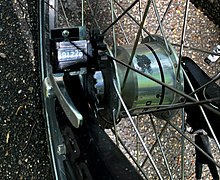138:
74:
17:
101:
Paul Oerth took up production in approximately 1990 and continued to about 2006. These models have a different gear ratio (260/11 counts per wheel revolution). In 2006, production of the necessary gears ceased, and an alternative plastic-encapsulated set of gears was introduced. This was short-lived,
152:
Before the counter is used, the bicycle must first be calibrated by being ridden on a straight section of road between marks whose separation has been accurately measured by steel tape. A calibration can then be calculated in terms of counts per kilometer. Next, the bicycle is ridden over the race
44:
race courses. The counter has gears that drive a mechanical digital counter. One count typically corresponds to about 1/20 of a wheel revolution (this varies if a different gear ratio is used); this provides a resolution of about 10 cm in course length, although overall accuracy, depending on
153:
course to determine its length. Finally, the bicycle is recalibrated by riding again over the calibration distance. This is done to check for changes in bicycle-wheel diameter due to temperature changes, air leakage, and other causes.
145:
To measure road-race courses, the counter is fitted to a bicycle between the left fork leg and the front wheel. The tab or tabs on the large ring gear engage with the spokes, thus providing drive to a
110:
The JOL counter is a variation of the Jones-Oerth model. Created by
Laurent Lacroix in 2000, its distinguishing feature is a 27" rotary cable that allows the user to mount the
181:
210:
81:
The original production version was manufactured by Alan Jones's son Clain from 1973 to 1982. The gearing produces 20 counts per revolution of the bicycle wheel.
122:
Development of a new model started in 2007. The first production units became available in April 2008 and were used for the measurement of the
303:
48:
Almost all road running courses in the world are measured with this device. The Jones
Counter has been used to measure all
137:
217:
277:
247:
198:
162:
298:
240:
129:
The gearing (260/11 counts per wheel revolution) is identical to that of the Jones-Oerth model.
53:
37:
90:
57:
262:
8:
146:
111:
33:
60:. In addition, it has often been used to measure Olympic Road Race Walking Courses.
49:
45:
calibration and other factors, is lower, but normally better than 1 part in 1,000.
251:
123:
292:
41:
20:
Jones
Counters: Upper- NYRRC model. Middle- Oerth model. Lower- Model JR
244:
73:
29:
16:
282:
36:
to a bicycle. It was developed in 1971 by Alan Jones to
132:
290:
105:
211:"Measurement News No 132 Summer 2006 page 32"
141:Jones Counter on the front wheel of a bicycle
102:and the Oerth model went out of production.
117:
136:
72:
15:
291:
126:, which took place on April 13, 2008.
96:
84:
68:
278:The Measurement of Road Race Courses
263:Picture in course measurement lesson
133:Use for measuring road-race courses
13:
182:"The History of the Jones Counter"
14:
315:
270:
93:from 1983 to approximately 1990.
304:Sport of athletics terminology
256:
234:
203:
192:
174:
163:Short course prevention factor
1:
168:
89:Production was taken over by
32:which adds the function of a
77:Original Jones Counter, 1975
7:
156:
106:Jones-Oerth-Lacroix Counter
10:
320:
63:
241:Course measurement forum
142:
118:Jones Counter model JR
78:
54:1976 Montreal Olympics
21:
140:
91:New York Road Runners
76:
28:is a type of bicycle
19:
299:Counting instruments
58:1980 Moscow Olympics
245:Designers' web site
147:Veeder-Root counter
114:on the handlebars.
112:Veeder-Root Counter
97:Jones-Oerth Counter
85:NYRRC Jones Counter
69:Clain Jones Counter
250:2008-07-08 at the
143:
79:
52:courses since the
38:accurately measure
22:
281:(handbook of the
311:
265:
260:
254:
238:
232:
231:
229:
228:
222:
216:. Archived from
215:
207:
201:
196:
190:
189:
178:
50:Olympic Marathon
34:surveyor's wheel
319:
318:
314:
313:
312:
310:
309:
308:
289:
288:
273:
268:
261:
257:
252:Wayback Machine
239:
235:
226:
224:
220:
213:
209:
208:
204:
199:Lacroix Counter
197:
193:
180:
179:
175:
171:
159:
135:
124:London Marathon
120:
108:
99:
87:
71:
66:
56:except for the
12:
11:
5:
317:
307:
306:
301:
287:
286:
272:
271:External links
269:
267:
266:
255:
233:
202:
191:
172:
170:
167:
166:
165:
158:
155:
134:
131:
119:
116:
107:
104:
98:
95:
86:
83:
70:
67:
65:
62:
40:the length of
9:
6:
4:
3:
2:
316:
305:
302:
300:
297:
296:
294:
284:
280:
279:
275:
274:
264:
259:
253:
249:
246:
242:
237:
223:on 2011-06-11
219:
212:
206:
200:
195:
187:
183:
177:
173:
164:
161:
160:
154:
150:
148:
139:
130:
127:
125:
115:
113:
103:
94:
92:
82:
75:
61:
59:
55:
51:
46:
43:
39:
35:
31:
27:
26:Jones Counter
18:
276:
258:
236:
225:. Retrieved
218:the original
205:
194:
185:
176:
151:
144:
128:
121:
109:
100:
88:
80:
47:
42:road running
25:
23:
293:Categories
227:2007-11-02
169:References
248:Archived
157:See also
30:odometer
64:Models
221:(PDF)
214:(PDF)
186:USATF
283:IAAF
24:The
295::
243:.
184:.
149:.
285:)
230:.
188:.
Text is available under the Creative Commons Attribution-ShareAlike License. Additional terms may apply.


